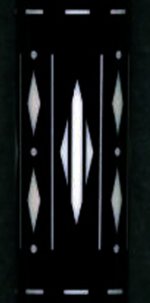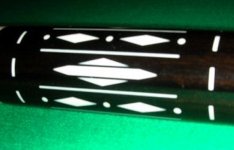The .tif file format is not compressed. Most cameras use the .jpg format which is a compressed file format. I don't see how it could account for this though. I will experiment with some cameras, resolution settings, and angles.
EDIT: I looked at the photos more closely. I believe this strange effect may be due to the lighting and/or flash. The corners of the inlays look more pointed the further away they are from the center of focus. The focus lies just at the tip of the rhombus closest to the wrap (the most rounded corner). Notice that the top set of dashes also look wider than they appear in the scanned version. I think that the white inlays produced hotspots/glare when the picture was taken, and subsequently compressed (by the camera). When the image was compressed the hotspots were interpolated by the compression algorithm as the same color value of as the inlays themselves. Compression algorithims compare the color value of each pixel to that of all its neighbors and approximate the value for each pixel for the final picture based on this, because the compression tosses away some color value, each pixel is assigned an artificial value. This is the trade off for smaller file size. The camera may be able to be set to do a better job, though, or you could just use different lighting... or both. The scanned images, though sharper, are lower contrast, and don't do justice to the cue, especially the wood grain.




